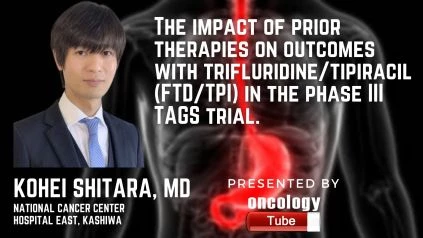Kohei Shitara, MD, Chief, Department of Gastrointestinal Oncology of the National Cancer Center Hospital East, Kashiwa discusses The impact of prior therapies on outcomes with trifluridine/tipiracil (FTD/TPI) in the phase III TAGS trial.
Context:
It is unclear if prior therapy with ramucirumab (RAM) or RAM plus paclitaxel (PAC), the standard second-line therapy for metastatic gastric or gastroesophageal junction cancer (mGC/GEJC), can affect the outcomes of third-line chemotherapy in this patient population (pt) (pop). FTD/TPI demonstrated a survival advantage vs. placebo (PBO) in pts with mGC/GEJC that had received = 2 previous chemotherapy regimens in the phase 3 TAGS trial. In order to determine the effect of prior RAM, PAC or RAM+PAC care on the efficacy and protection of FTD/TPI in TAGS, post hoc tests were conducted.
Methodology:
A) RAM (alone or in combination with other agents), B) no RAM, C) PAC (but no RAM), D) RAM+PAC (sequentially or in combination) and E) neither PAC nor RAM were classified into 5 subgroups in the TAGS trial based on prior care obtained. All other subgroups were defined post hoc, while subgroups A and B were prespecified. In these subgroups, efficacy (overall survival [OS] and progression-free survival [PFS]) and safety were assessed.
Outcomes:
33 percent had previous RAM (alone/combined) in the overall pop (N=507); 30 percent prior RAM+PAC; 27 percent prior PAC but no RAM; and 40 percent had neither PAC nor RAM got. Since only 3% of all pts earned prior RAM but no PAC, this subgroup was not taken into account in this study. The advantage of OS and PFS vs placebo across all pt subgroups was consistently correlated with FTD/TPI treatment (Table). OS gain was comparable among pts randomized to FTD/TPI between pts receiving RAM+PAC vs those receiving neither (HR, 1.15; 95 percent CI, 0.84-1.58) and between pts receiving PAC (but no RAM) vs those receiving neither (HR, 0.91; 95 percent CI, 0.66-1.25). The FTD/TPI protection profile was consistent across all subgroups, with grade = 3 adverse events having comparable overall incidences (AEs). Minor differences have been reported in hematological toxicities (Table).
Findings:
FTD/TPI care in the third or later line offered efficacy advantages vs. PBO in the phase 3 TAGS trial and demonstrated a robust safety profile in mGC/GEJC pts irrespective of previous treatments.

